
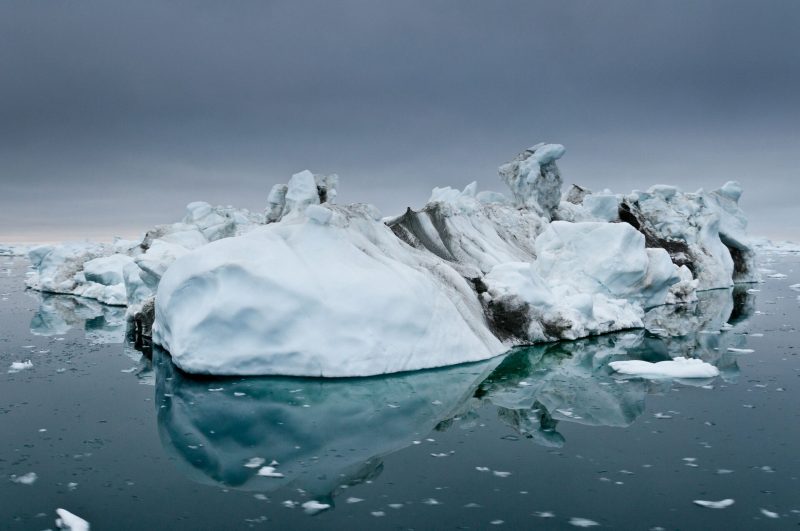
Image via ESA.
Multiple studies released this year paint a dire picture of the ongoing melting of Earth’s freshwater ice sheets and glaciers, 99% of which are found in Greenland and Antarctica. We briefly outline three recent studies, and provide links to sources and further reading in this post.
The three studies mentioned here suggest that two major Antarctic glaciers are tearing loose from their restraints, that ice melt matches worst-case scenarios in both Antarctica and Greenland, and many ice shelves in Antarctica are vulnerable to quick destruction.
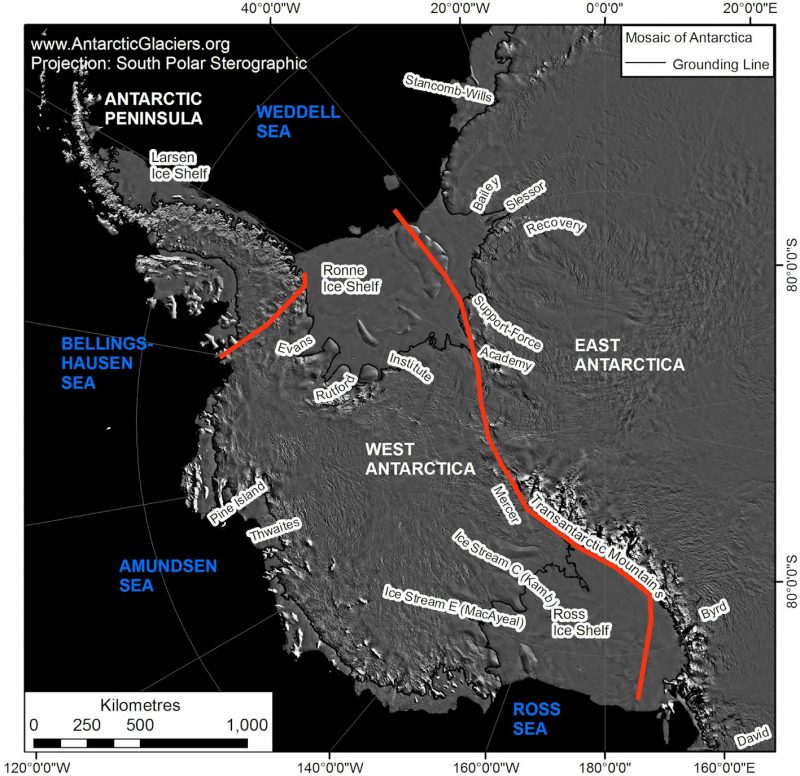
Pine Island and Thwaites glaciers in the West Antarctic ice sheet. Image via antarcticglaciers.org.
Antarctic glaciers tearing loose. A study based on satellite imagery over Antarctica focuses on two very large, long-watched glaciers: Pine Island glacier and Thwaites glacier, sometimes referred to in the media as the doomsday glacier. The study shows that both glaciers are breaking free from the restraints that have so far impeded their rapid flow toward the ocean. Once loosened from these restraints, both glaciers can be expected to have a major effect on global sea level rise.
Chris Mooney reported on the new study of Thwaites and Pine Island glaciers in the Washington Post on September 14, 2020. He wrote:
Located along the coast of the Amundsen Sea in West Antarctica, the enormous Pine Island and Thwaites glaciers already contribute around 5% of global sea-level rise. The survival of Thwaites has been deemed so critical that the United States and Britain have launched a targeted multimillion-dollar research mission to the glacier. The loss of the glacier could trigger the broader collapse of the West Antarctic ice sheet, which contains enough ice to eventually raise seas by about 10 feet (3 meters).
The new findings – published on September 14, 2020 in the Proceedings of the National Academy of Sciences – come from analysis of satellite images. They show that a naturally occurring buffer system that prevents the glaciers from flowing outward rapidly is breaking down, potentially unleashing far more ice into the sea in coming years.
Scientists can see that their shear margins – where their floating ice shelves encounter high levels of friction that constrain the natural flow of ice, are progressively weakening and in some cases breaking into pieces.
Mooney also speaks in his article about the fact that – as of September 1, 2020 – Arctic sea ice extent stood at its second-lowest extent for that date in the satellite record that started in 1979. And, he writes, last month, Canada lost a large portion of its last major Arctic ice shelf. And there’s more. Mooney’s article provides an excellent overview and some depth on the subject of melting freshwater ice across Earth.
Read more from Chris Mooney via the Washington Post
Source: Damage accelerates ice shelf instability and mass loss in Amundsen Sea Embayment
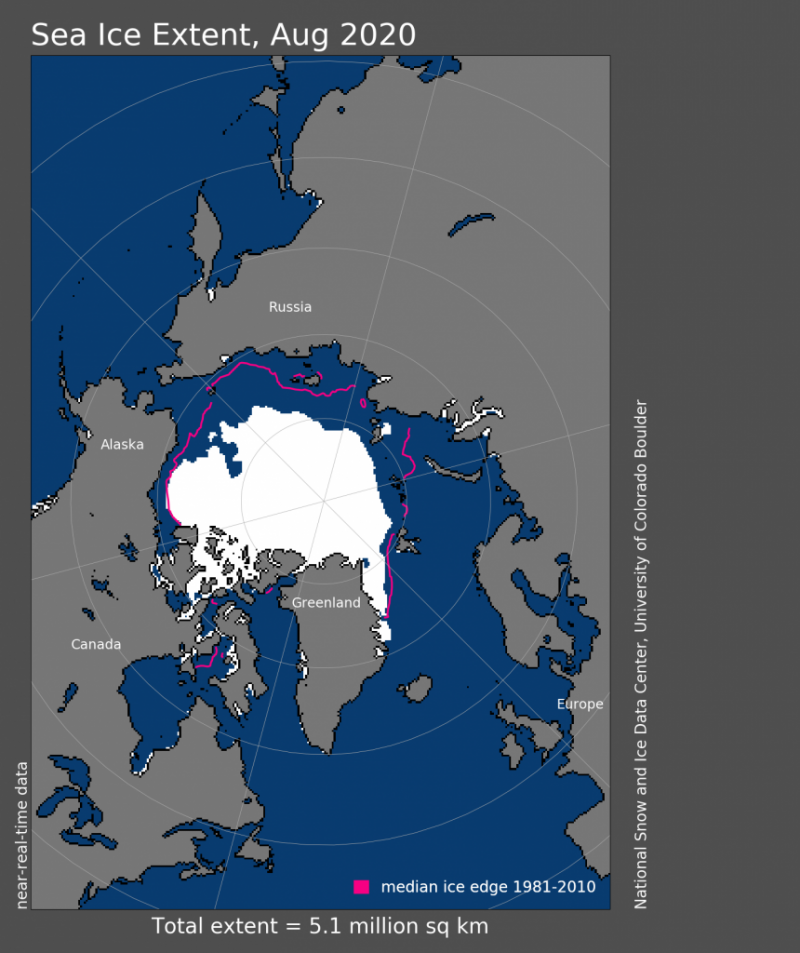
Arctic sea ice extent for August 2020 was 5.08 million square kilometers (1.96 million square miles). The magenta line shows the 1981 to 2010 average extent for that month. Map via the National Snow and Ice Data Center.
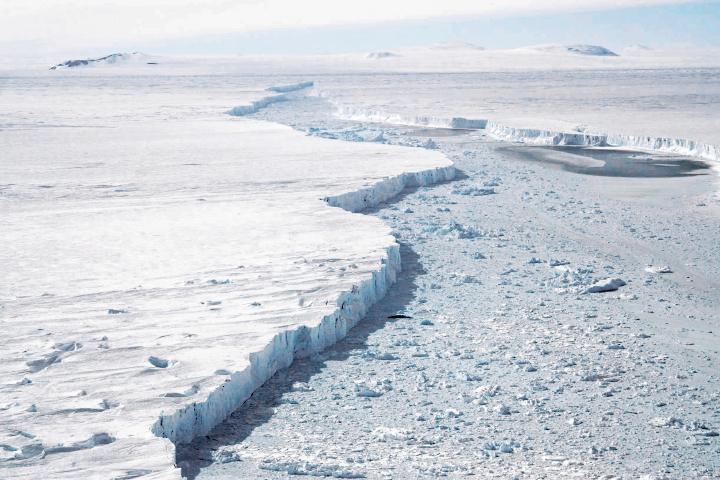
As it flows, Pine Island Glacier in Antarctica frequently calves icebergs to the Amundsen Sea, an arm of the Southern Ocean encircling Antarctica. This is the glacier as a huge iceberg calved on November 7, 2018. Image via Operation Ice Bridge/ NASA Earth Observatory.
Ice melt matches worst-case scenarios. The European Space Agency (ESA) reported September 8, 2020, on a recent study confirming that ice sheets in both Greenland and Antarctica, where the ice-loss rates have been rapidly increasing, are matching the Intergovernmental Panel on Climate Change’s worst-case sea-level rise scenarios.
This study was published in the peer-reviewed journal Nature Climate Change on August 31. It compares ice-sheet mass-balance results from satellite observations with projections from climate models. ESA explained:
Since the systematic monitoring of ice sheets began in the early 1990s, Greenland and Antarctica combined lost 6.4 trillion metric tons of ice between 1992 and 2017 – pushing global sea levels up by 0.7 inches [17.8 millimeters]. If these rates continue, ice sheets are expected to raise sea levels by approximately 6.7 inches [17 cm] – exposing an additional 16 million people to annual coastal flooding by the end of the century.
Tom Slater, lead author of the study and climate researcher at the Centre for Polar Observation and Modelling at the University of Leeds, commented:
Satellites are our only means of routinely monitoring these vast and remote areas, so they are absolutely critical in providing measurements which we can use to validate ice sheet models.
Read more about this study via ESA
Source: Ice-sheet losses track high-end sea-level rise projections

Tom Slater, via University of Leeds.
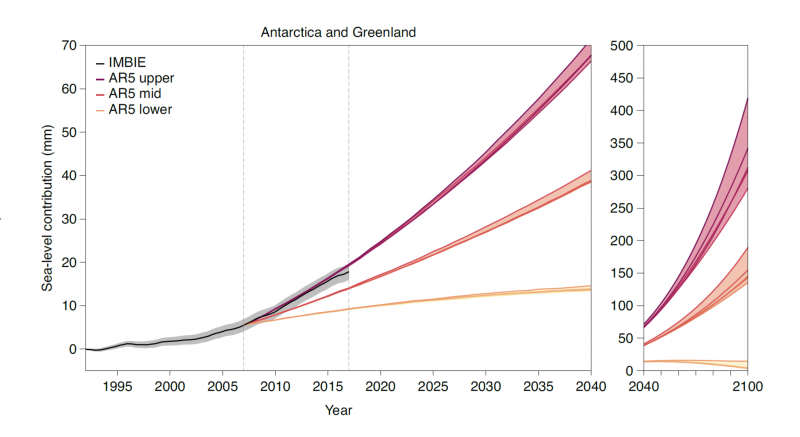
The Antarctic and Greenland ice sheet contribution to global sea level according to IMBIE (black), compared to satellite observations and projections between 1992-2040 (left) and 2040-2100 (right). Image via ESA.
Antarctic ice shelves vulnerable. Here’s a final piece of bad news, from the Earth Institute at Columbia University in New York, New York. Kevin Krajick, who is a senior editor there and who blogs on Earth-related topics, reported on August 26, 2020, on a new study showing that many of the ice shelves surrounding Antarctica could be vulnerable to quick destruction if rising temperatures drive melt water into the many fractures that already penetrate their surfaces. Krajick’s report is based on a scientific study published in the peer-reviewed journal Nature, led by Ching-Yao Lai at Columbia University’s Lamont-Doherty Earth Observatory. Krajick wrote:
The shelves help slow interior glaciers’ slide toward the ocean, so if they were to fail, sea levels around the world could surge rapidly as a result …
Ice shelves are giant tongues of ice floating on the ocean around the edges of the continent. The vast land-bound glaciers behind them are constantly pushing seaward. But because many shelves are largely confined within expansive bays and gulfs, they are compressed from the sides and slow the glaciers’ march – somewhat like a person in a narrow hallway bracing their arms against the walls to slow someone trying to push past them.
But ice shelves experience a competing stress: they stretch out as they approach the ocean. Satellite observations show that, as a result, they rip apart; most are raked with numerous long fractures perpendicular to the direction of stretching. Fractures that form at the surface can be tens of meters deep; others, forming from the bottom, can penetrate the ice hundreds of meters upward. Some fractures are hundreds of meters wide.
Currently, most of the shelves are frozen year round, and stable. But scientists project that widespread warming could occur later in the century. And, existing research has shown that even subtle temperature swings can spur widespread melting. This could send melt water surging into the surface fractures. Such surges would potentially cause hydrofracturing – a process in which liquid water, heavier than ice, would violently force the fractures to zip open, and cause the shelf to rapidly disintegrate.
The new study estimates that 50% to 70% of the areas of the ice shelves buttressing the glaciers are vulnerable to such processes.
Lead author Ching-Yao Lai added:
It’s not just about melting, but where it’s melting.
Read more via the Earth Institute
Source: Vulnerability of Antarctica’s ice shelves to meltwater-driven fracture

Ching-Yao Lai via The Earth Institute.
Bottom line: The three studies mentioned in this post suggest that two major Antarctic glaciers are tearing loose from their restraints, that ice melt matches worst-case scenarios in both Antarctica and Greenland, and many ice shelves in Antarctica are vulnerable to quick destruction.
Quick facts about ice sheets and glaciers from the National Snow and Ice Data Center
from EarthSky https://ift.tt/2FGYKAw


Image via ESA.
Multiple studies released this year paint a dire picture of the ongoing melting of Earth’s freshwater ice sheets and glaciers, 99% of which are found in Greenland and Antarctica. We briefly outline three recent studies, and provide links to sources and further reading in this post.
The three studies mentioned here suggest that two major Antarctic glaciers are tearing loose from their restraints, that ice melt matches worst-case scenarios in both Antarctica and Greenland, and many ice shelves in Antarctica are vulnerable to quick destruction.

Pine Island and Thwaites glaciers in the West Antarctic ice sheet. Image via antarcticglaciers.org.
Antarctic glaciers tearing loose. A study based on satellite imagery over Antarctica focuses on two very large, long-watched glaciers: Pine Island glacier and Thwaites glacier, sometimes referred to in the media as the doomsday glacier. The study shows that both glaciers are breaking free from the restraints that have so far impeded their rapid flow toward the ocean. Once loosened from these restraints, both glaciers can be expected to have a major effect on global sea level rise.
Chris Mooney reported on the new study of Thwaites and Pine Island glaciers in the Washington Post on September 14, 2020. He wrote:
Located along the coast of the Amundsen Sea in West Antarctica, the enormous Pine Island and Thwaites glaciers already contribute around 5% of global sea-level rise. The survival of Thwaites has been deemed so critical that the United States and Britain have launched a targeted multimillion-dollar research mission to the glacier. The loss of the glacier could trigger the broader collapse of the West Antarctic ice sheet, which contains enough ice to eventually raise seas by about 10 feet (3 meters).
The new findings – published on September 14, 2020 in the Proceedings of the National Academy of Sciences – come from analysis of satellite images. They show that a naturally occurring buffer system that prevents the glaciers from flowing outward rapidly is breaking down, potentially unleashing far more ice into the sea in coming years.
Scientists can see that their shear margins – where their floating ice shelves encounter high levels of friction that constrain the natural flow of ice, are progressively weakening and in some cases breaking into pieces.
Mooney also speaks in his article about the fact that – as of September 1, 2020 – Arctic sea ice extent stood at its second-lowest extent for that date in the satellite record that started in 1979. And, he writes, last month, Canada lost a large portion of its last major Arctic ice shelf. And there’s more. Mooney’s article provides an excellent overview and some depth on the subject of melting freshwater ice across Earth.
Read more from Chris Mooney via the Washington Post
Source: Damage accelerates ice shelf instability and mass loss in Amundsen Sea Embayment

Arctic sea ice extent for August 2020 was 5.08 million square kilometers (1.96 million square miles). The magenta line shows the 1981 to 2010 average extent for that month. Map via the National Snow and Ice Data Center.

As it flows, Pine Island Glacier in Antarctica frequently calves icebergs to the Amundsen Sea, an arm of the Southern Ocean encircling Antarctica. This is the glacier as a huge iceberg calved on November 7, 2018. Image via Operation Ice Bridge/ NASA Earth Observatory.
Ice melt matches worst-case scenarios. The European Space Agency (ESA) reported September 8, 2020, on a recent study confirming that ice sheets in both Greenland and Antarctica, where the ice-loss rates have been rapidly increasing, are matching the Intergovernmental Panel on Climate Change’s worst-case sea-level rise scenarios.
This study was published in the peer-reviewed journal Nature Climate Change on August 31. It compares ice-sheet mass-balance results from satellite observations with projections from climate models. ESA explained:
Since the systematic monitoring of ice sheets began in the early 1990s, Greenland and Antarctica combined lost 6.4 trillion metric tons of ice between 1992 and 2017 – pushing global sea levels up by 0.7 inches [17.8 millimeters]. If these rates continue, ice sheets are expected to raise sea levels by approximately 6.7 inches [17 cm] – exposing an additional 16 million people to annual coastal flooding by the end of the century.
Tom Slater, lead author of the study and climate researcher at the Centre for Polar Observation and Modelling at the University of Leeds, commented:
Satellites are our only means of routinely monitoring these vast and remote areas, so they are absolutely critical in providing measurements which we can use to validate ice sheet models.
Read more about this study via ESA
Source: Ice-sheet losses track high-end sea-level rise projections

Tom Slater, via University of Leeds.

The Antarctic and Greenland ice sheet contribution to global sea level according to IMBIE (black), compared to satellite observations and projections between 1992-2040 (left) and 2040-2100 (right). Image via ESA.
Antarctic ice shelves vulnerable. Here’s a final piece of bad news, from the Earth Institute at Columbia University in New York, New York. Kevin Krajick, who is a senior editor there and who blogs on Earth-related topics, reported on August 26, 2020, on a new study showing that many of the ice shelves surrounding Antarctica could be vulnerable to quick destruction if rising temperatures drive melt water into the many fractures that already penetrate their surfaces. Krajick’s report is based on a scientific study published in the peer-reviewed journal Nature, led by Ching-Yao Lai at Columbia University’s Lamont-Doherty Earth Observatory. Krajick wrote:
The shelves help slow interior glaciers’ slide toward the ocean, so if they were to fail, sea levels around the world could surge rapidly as a result …
Ice shelves are giant tongues of ice floating on the ocean around the edges of the continent. The vast land-bound glaciers behind them are constantly pushing seaward. But because many shelves are largely confined within expansive bays and gulfs, they are compressed from the sides and slow the glaciers’ march – somewhat like a person in a narrow hallway bracing their arms against the walls to slow someone trying to push past them.
But ice shelves experience a competing stress: they stretch out as they approach the ocean. Satellite observations show that, as a result, they rip apart; most are raked with numerous long fractures perpendicular to the direction of stretching. Fractures that form at the surface can be tens of meters deep; others, forming from the bottom, can penetrate the ice hundreds of meters upward. Some fractures are hundreds of meters wide.
Currently, most of the shelves are frozen year round, and stable. But scientists project that widespread warming could occur later in the century. And, existing research has shown that even subtle temperature swings can spur widespread melting. This could send melt water surging into the surface fractures. Such surges would potentially cause hydrofracturing – a process in which liquid water, heavier than ice, would violently force the fractures to zip open, and cause the shelf to rapidly disintegrate.
The new study estimates that 50% to 70% of the areas of the ice shelves buttressing the glaciers are vulnerable to such processes.
Lead author Ching-Yao Lai added:
It’s not just about melting, but where it’s melting.
Read more via the Earth Institute
Source: Vulnerability of Antarctica’s ice shelves to meltwater-driven fracture

Ching-Yao Lai via The Earth Institute.
Bottom line: The three studies mentioned in this post suggest that two major Antarctic glaciers are tearing loose from their restraints, that ice melt matches worst-case scenarios in both Antarctica and Greenland, and many ice shelves in Antarctica are vulnerable to quick destruction.
Quick facts about ice sheets and glaciers from the National Snow and Ice Data Center
from EarthSky https://ift.tt/2FGYKAw

Aucun commentaire:
Enregistrer un commentaire